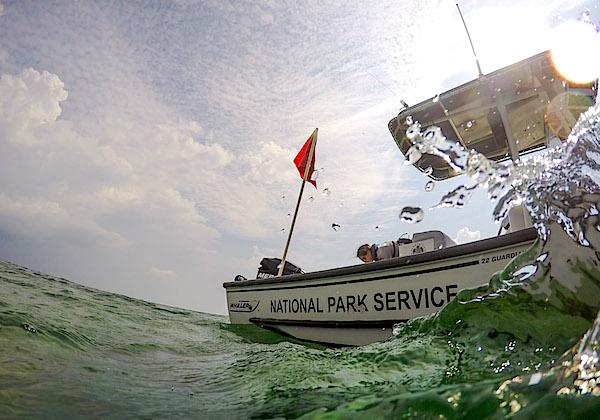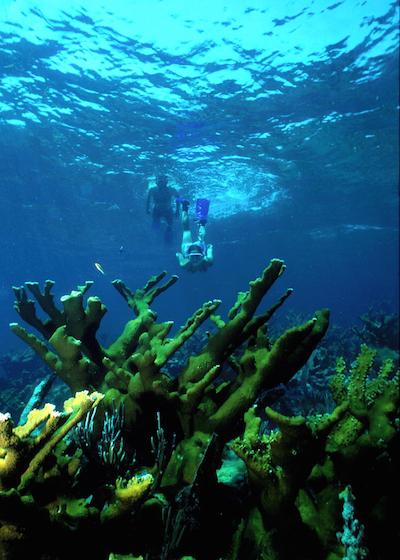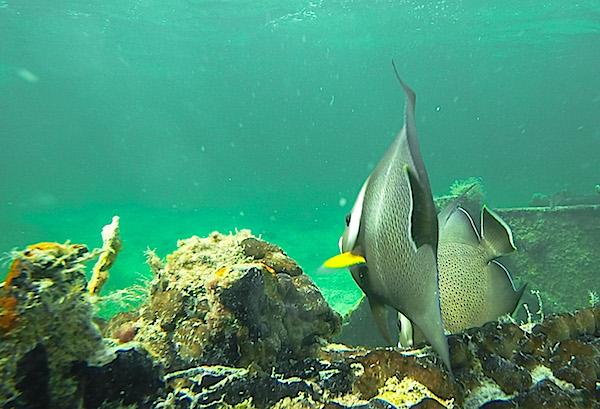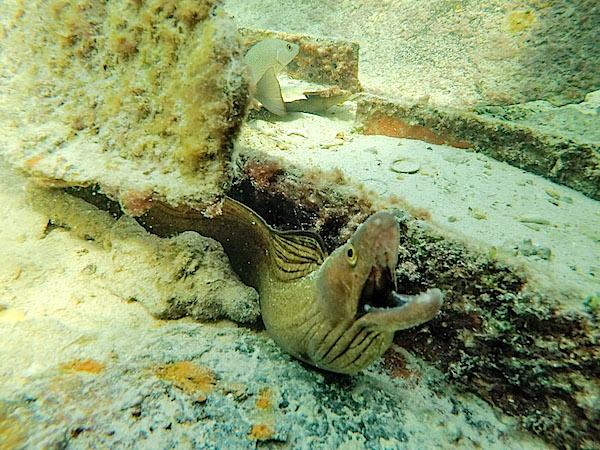
Biscayne National Park is 95 percent water, making it an incredible attraction for anglers, snorkelers, and divers/Jameson Clifton
The deafening roar of the 225-horsepower Mercury engine propelled our skiff across the turquoise expanse of Biscayne Bay. It was hard to imagine that less than an hour earlier I'd been sipping a cafe cubano in the heart of downtown Miami. Here we were though, making headway toward an offshore reef to explore some of South Florida's renowned marine habitat.
The early morning sun glistened atop the ocean waterscape before us, backlighting the salty spray of the waves as they broke across our bow. According to the forecast, poor weather would move in by the early afternoon, so with the rough chop already hammering our little boat, and the intended destination another 4 miles offshore, we decided to moor at one of the closer reefs.
We were eager to explore, and donned our snorkel gear and made the plunge into the pleasantly warm 76° F water. We floated on the surface, above the colorful marine oasis. It provided a sense of tranquility. Streaks of sunlight illuminated the anemones, which swayed gently back and forth on the seafloor, mesmerizingly in the rolling swell. It was a stark contrast to the rough voyage just moments before. The only sound was the soft rumble of the waves, and a steady rhythm with each breath: in and out.
While most national parks are dominated by landscapes, Biscayne National Park is unique in that 95 percent is covered by water. There are 10,000 years of colorful human history here nestled among mangrove forests, coral reefs, sea grass meadows, lighthouses, and shipwrecks. The setting has been shaped by Native Americans, farmers, smugglers, fishermen, pirates, and presidents.
The watery underworld has historically featured a wondrous and bountiful array of species, from bonefish, tarpon and oysters to groupers, barracuda, spiny lobster, and lustrous parrotfish. However, of the few hundred species that inhabit the park's waters, 150 have faced population pressures from recreational and commercial fishing, according to the National Park Service.

Biscayne National Park is a diver's paradise, and park officials hope to improve on that paradise through their upcoming General Management Plan/NPS
It'd been 10 months since I had been on the ocean, since departing my home on the east coast of Australia. It felt great to be back in the water. With the guidance of our Park Service companions, we identified several Purplemouth Morays, Sergeant Majors, Gray Angelfish, and plenty of invasive lionfish, not to mention a beautiful conch species. We explored the reef, and later, a sunken pontoon boat. It was an exhilarating experience, one I never wanted to end. What was missing, unfortunately, were larger species that I'd seen just a week earlier in Key West.
According to the National Parks Conservation Association, "Coral reef health and fish populations in Biscayne National Park have been on the decline for decades due to overfishing and over-use, leaving some species on the verge of collapse." That explains it. In 2001, scientists warned that the park's fisheries were facing "imminent collapse" without immediate help and protection.
Preservation is one of the National Park Service's foremost of goals, so how had this come about? True, when the National Park Service was created in 1916 its mission also called for providing a public place, "or pleasuring-ground for the benefit and enjoyment of the people." But the National Park Service Organic Act also emphasized that the "fundamental purpose of the parks is to conserve the scenery; natural and historic objects; and the wildlife therein," thus leaving them "unimpaired for the enjoyment of future generations."
With that in mind, a proactive protection plan for Biscayne National Park would seem relatively straightforward. Unfortunately, for the past 15 years officials, environmentalists, anglers, and boaters have struggled to agree on an appropriate strategy, leaving the future of America's largest marine park, and part of the only tropical coral reef system in the continental United States, unresolved.
"Biscayne is a national park," Superintendent Brian Carlstrom told The New York Times late last year. "If this were national park land there would be no question of what resources can be extracted from here."
Though managed by a federal agency, the park's enabling legislation places much of Biscayne's waters under regulations from the State of Florida. An exception has been given that allows Park Service rule-making authority for areas that fall within the boundaries of the original Biscayne National Monument when it was established in 1968. Thus, politics and economics have become entwined to cast an ecosystem out of balance.
With the nation's fourth-largest metropolitan area within sight of the park, fishing stocks are under immense pressure not only from South Florida's booming population but also commercial operations. Advancements in fishing technology have made it easier to locate and catch fish than ever before.
Fortunately, the state and federal governments appear to have reached a compromise, with a finalized General Management Plan (GMP) expected to be released this summer. To date there have been seven proposed alternatives, each with varying levels of effectiveness and complexity. In a very public debate, members of the public and other stakeholders were encouraged to comment on each.
While the public comment period ended on February 20, 2014, integrating the comments "with no small amount of political pressure" into a final GMP hasn't been quick or easy. With so many different voices and proposed alternatives, many in the community couldn't keep track.

Unlike many reefs, some in Biscayne National Park have relatively few fish/Jameson Clifton
Caroline McLaughlin, NCPA's Biscayne restoration program analyst, told me, "I think one of the problems is a lack of information, or misinformation going around. This is really an opportunity to preserve the resources of Biscayne, address problems in relation to a significant decline in reef ecosystem health, and fisheries populations, in order to preserve those ecosystems for the future."
Many in the fishing community, continued McLaughlin, had actually shown "a great deal of support" for tighter regulations in the form of a "no-take" Marine Reserve Zone (MRZ) at some of the critically affected areas within the park's boundaries, noting that in other MRZs the fishing was often best just outside those areas.
Vanessa McDonough, Biscayne National Park's fishery and marine biologist, sympathized with the need for an MRZ, as well as increased public awareness and education on some of the issues facing the park. She noted that restrictions at land-based national parks are generally understood and accepted, but people often don't apply the same ideology to underwater resources. "You can't shoot bison in Yellowstone," she said. "National parks should be held to a higher standard."
Exactly how the final GMP will integrate an MRZ is unclear. But going into the final draft, the proposed MRZ would cover approximately 7 percent of the park's waters, or 10,522 acres, and protect 2,663 acres of the park's coral reefs. Significantly, placing that acreage of coral reefs into a marine reserve would contribute towards the U.S. Coral Reef Task Force's goal of having 20 percent of Florida's reefs within such reserves.
Under an MRZ designation -- which could be applied to areas within the original Biscayne National Monument's boundaries -- recreational and commercial fishing would be banned to encourage long-term protection and recovery of the reef ecosystem, although recreational boating, snorkeling, and diving would be permitted.

Moray eels, sea fans, and a variety of corals all would benefit from fewer user impacts/Jameson Clifton
This approach has been scientifically proven as the preferred course of action, according to environmentalists. An open letter, co-signed by Jean-Michel Cousteau founder of the Ocean's Future Society, National Geographic Explorer- in-Residence Sylvia Earle, and Senior Scientist Emeritus Jeremy Jackson at the Smithsonian Tropical Research Institute, to Interior Secretary Sally Jewell stressed this: "The establishment of a marine reserve is the best, most effective method for protecting Biscayne's severely threatened coral reef ecosystem."
Proof of the ecological benefits of such a reserve can be found off of Florida's southern tip at Dry Tortugas National Park. That park's Research Natural Area has led to "increases in the size and abundance of many overexploited species within the reserve areas and spillover of more and larger fish occurred outside of reserve boundaries," the letter adds.
A combination of draft Alternative 4 (creation of a Marine Reserve Zone) and Alternative 7 (a special recreation zone that would prohibit some types of fishing year-round and close recreational fishing during the summer months) outlined in the supplemental draft GMP appears to preview what General Management Plan likely will look like. How it will be received by the state, and the angling public, will go a long way to determining how soon Biscayne's defining aspect can heal itself from decades of overuse.
Jameson Clifton, a University of Utah student, is an editorial intern for the Traveler. He previously wrote about ski touring in Yellowstone National Park, sea kayaking at Fiordland National Park in New Zealand, and the Florida Wildlife Corridor Expedition.



Comments
Fascinating. Thank you, Jameson.
But one sentence stands out and that one sentence says a lot: "Thus, politics and economics have become entwined to cast an ecosystem out of balance."